
Arizona has the most venomous snakes of any state with 21 in total, so hikers have to be careful.
©iStock.com/pmphoto
Arizona is one of the states that is known for having the most snakes. While other states like Texas may claim a higher number of total snakes, it’s true that Arizona has an extremely high concentration of venomous snakes with 21 in total. With Arizona being home to a large population and popular attractions ranging from lakes to the Grand Canyon, it helps to be aware of which snakes you might come across and which ones are potentially dangerous. Below, we’ll dig into some of the more common snakes in Arizona to know.
Nonvenomous and Common Snakes In Arizona
As you might expect Arizona has a lot of snakes that are known for thriving in extremely dry and hot climates. There are no aquatic snakes in Arizona. Some of the different types of nonvenomous snakes that you will find in Arizona are:
Arizona Milk Snake

Milk snakes mimic the color of venomous snakes (such as the coral snake) but aren’t dangerous.
©Matt Jeppson/Shutterstock.com
Arizona milk snakes, like other milk snakes, can initially be frightening because they have a very similar color pattern to venomous coral snakes. There are venomous coral snakes in Arizona so knowing the difference between a milk snake and coral snake is critically important if you’re in the state. Milk snakes have wide red bands like coral snakes.
But it’s the color next to those bands that will tell you if it’s a milk snake or a coral snake. Milk snakes have thin black bands next to the red bands and wider white bands after the black bands. A coral snake will have yellow bands next to the red bands. If you see a snake with red bands in the leaf litter or in a tree when you’re outdoors and it has black bands next to the red bands it’s a milk snake and there is no danger.
Glossy Snake

Glossy snakes can grow up to about five feed long
©Jason Mintzer/Shutterstock.com
Glossy snakes resemble gopher snakes in size and color. They are usually anywhere from three to five feet long and prefer arid desert habitats. Glossy snakes have a range of colors but they are all light and look like they are faded from the sun. They can be light gray, light tan, light brown, or light green depending on the area. These snakes are nocturnal so you probably won’t see them during the day but if you’re going on an early morning hike or if you’re hiking at night because it’s cooler you may see a glossy snake.
Desert King Snake
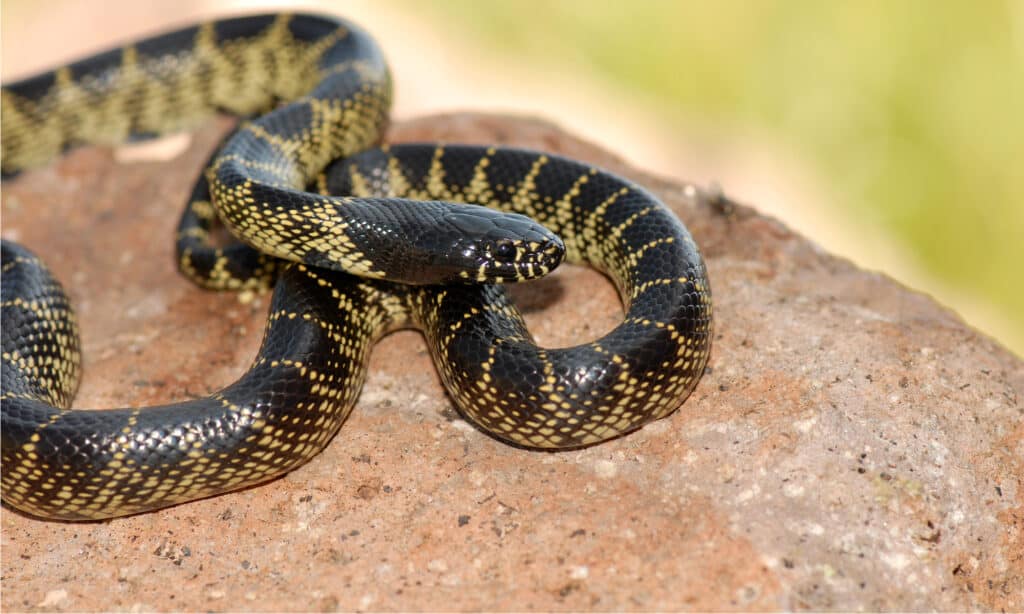
Desert kingsnakes have a black and yellow pattern.
©Rusty Dodson/Shutterstock.com
Desert king snakes might seem like a threat because they have stout bodies and they can be pretty long. They can grow up to six feet long although typically they are more like five feet long. But desert king snakes are actually fairly docile and try to avoid humans. If you come upon a desert king snake it will usually try to flee. But if it doesn’t slither away it may try to play dead by flipping over on its back and lying motionless until you walk away.
Blackneck Garter Snake
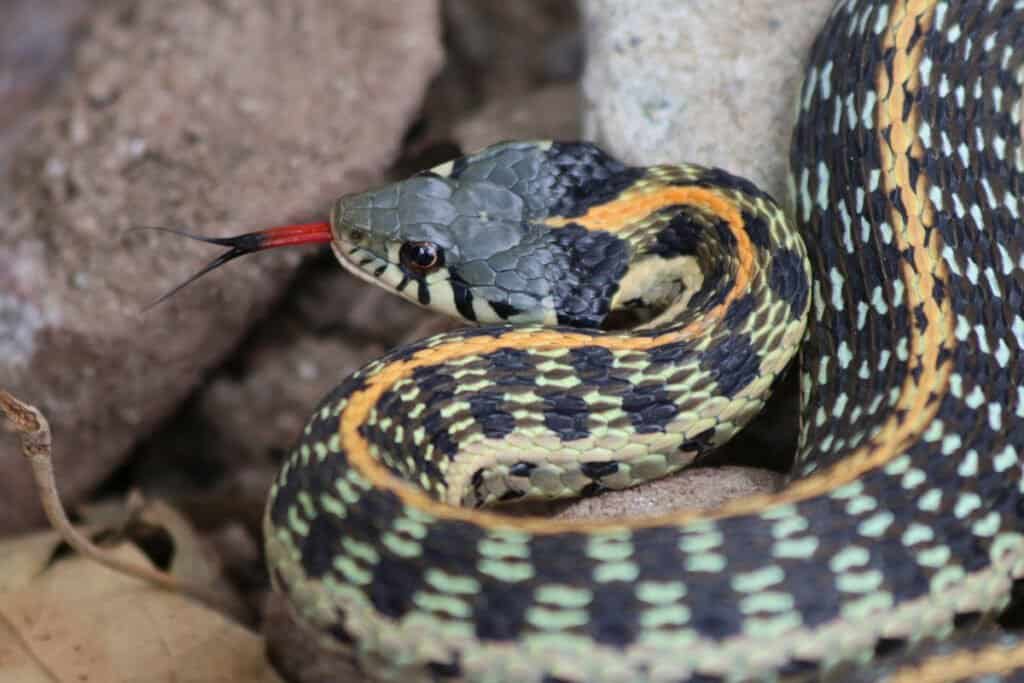
Blackneck Garter Snake
©Creeping Things/Shutterstock.com
You can find blackneck garter snakes in central and southeastern Arizona, typically near some type of water source. Since water sources in Arizona can be hard to find you will often find black-necked snakes gathered near ponds, streams, or lakes. You may also find them in the yards of homes that have water sources in the yard. Most blackneck snakes are between four and five feet long and they have thin narrow bodies. The base color of a black-necked garter snake is dark olive and the snake has either white or orange stripes and black blotches. There is a black ring around the neck of this snake.
Sonoran Gopher Snake

A gopher snake is coiled up and ready to strike.
©rawaccess/Shutterstock.com
Sonoran gopher snakes are only generally about four feet long but they look bigger because they have very wide bodies. Their primary diet is rodents and mice, which they kill by constricting, which is why they have such heavy heavy bodies. Gopher snakes are all over Arizona. You can find them from Fort Huachuca to Santa Cruz County and throughout the rest of the state. Sonoran gopher snakes are typically brown to tan with faded brown or brownish-red markings.
Southwestern Blackhead Snake
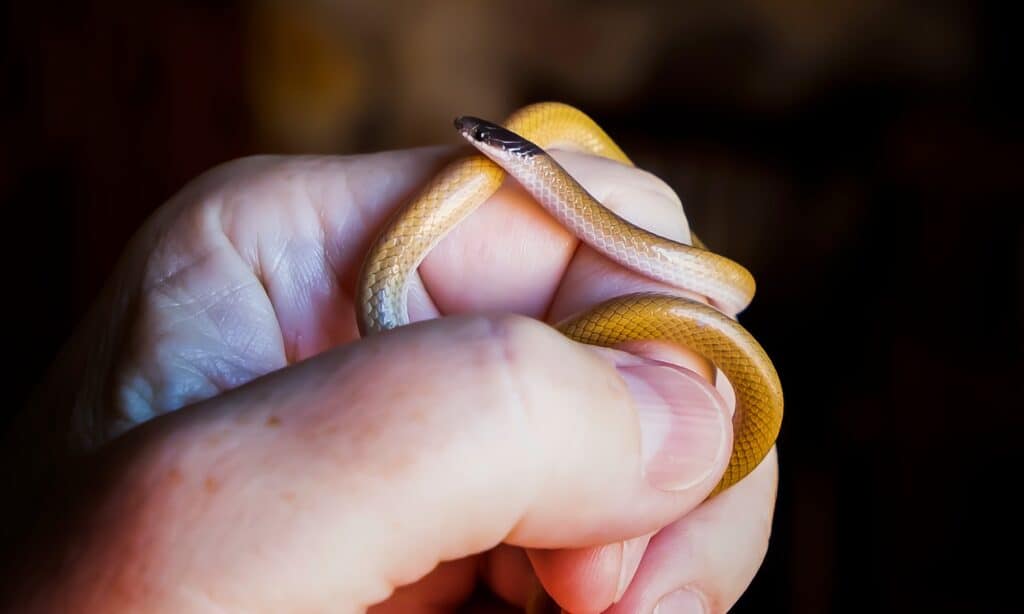
Southwestern blackhead snakes are an extremely small species.
©Erin Donalson/Shutterstock.com
If you live in Arizona you may find a southwestern blackhead snake in your home or you may find a bunch of them in your yard. That is a good thing. Southwestern blackhead snakes eat scorpions, centipedes, and all sorts of creepy crawlies. They’re only about eight inches long. Typically they are light tan or light brown with a faded blackhead. Southwestern blackhead snakes are completely harmless to humans. They actually do a great service for humans by eating scorpions and other pests. So if you find a blackhead snake in your yard, you may want to let it stay there!
Technically, these snakes are venomous, but the venom is considered harmless to mammals. Instead, the snakes mostly prey on spiders and insects.
Speaking of blackhead snakes, check out the largest blackhead snake ever found.
Western Shovelnose Snake
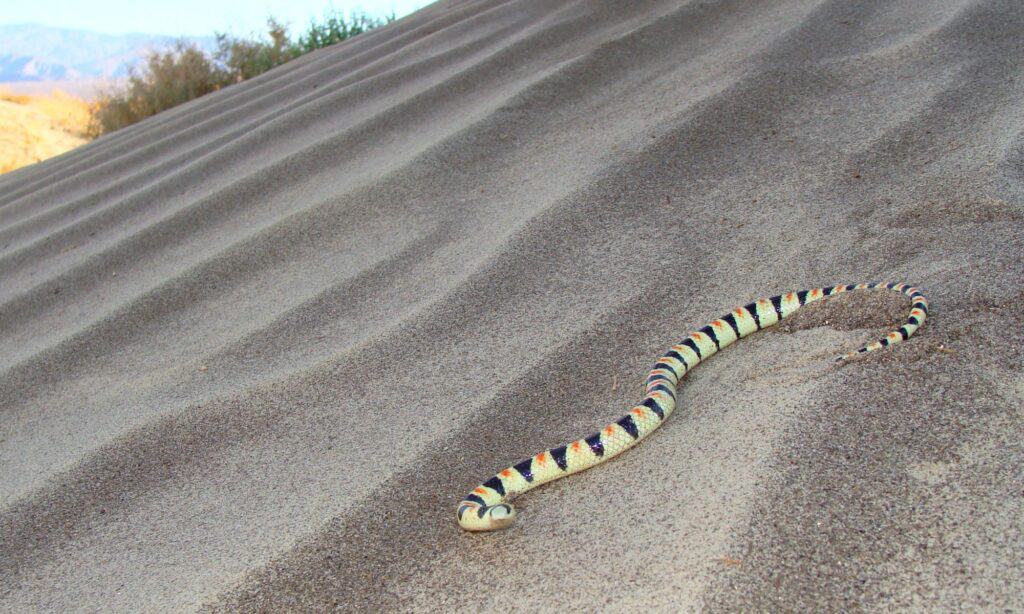
Shovelnose snakes have an adapted snout that’s ideal for digging through sand.
©Matt Jeppson/Shutterstock.com
The western shovelnose snake has a very unique facial structure. The nose is flat and jutted forward like a shovel so that the snake can essentially swim through the sand. That’s why this desert snake is so at home in Arizona. Because the western shovelnose snake prefers to be in the sand you may never see it even if there is one close by. Typically these snakes are just about 14 inches long. Their small size and ability to hide in the sand make them tough to see. They are no threat to humans.
Night Snake
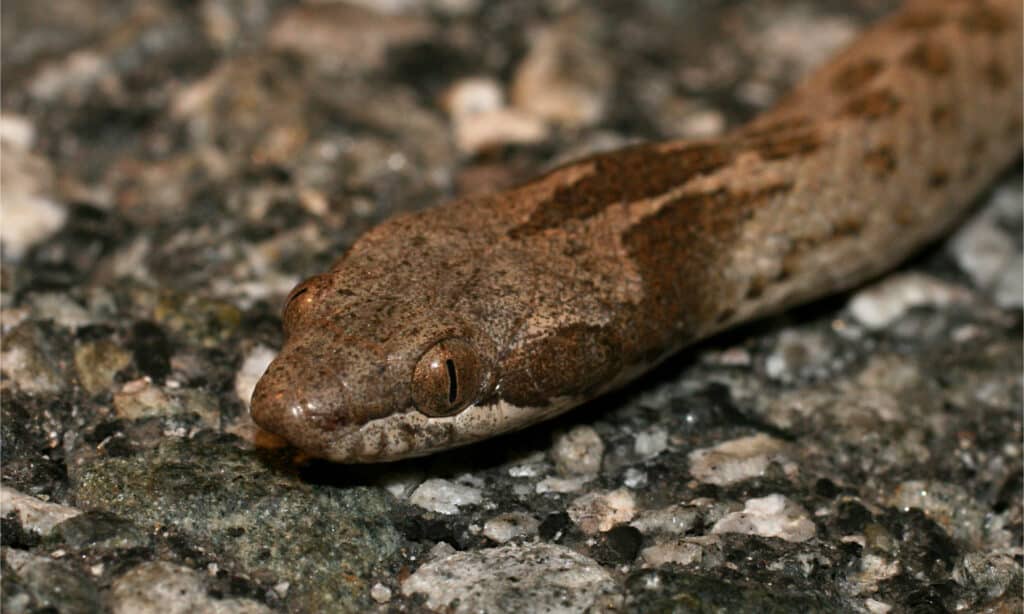
Night snakes are so named because they hunt at night.
©Casey K. Bishop/Shutterstock.com
Night snakes are very small. They typically are just about two feet long. Sometimes they are mistaken for young rattlesnakes. Most of the time these snakes are going to be light gray or light tan with dark brown or black blotches. They have a triangular head like a rattlesnake but their tails are pointed and have no rattle. They are most active at night, so you may see one crossing a road or a trail at night.
While night snakes are venomous, they generally pose no threat to humans.
Venomous Snakes In Arizona
Arizona has the most venomous snakes of any state. Most of the venomous snakes in Arizona are rattlesnakes. Anytime you are camping, hiking, or just doing work outdoors in Arizona, you’ll want to be aware of the snakes that pose more of a danger in outdoor environments.
If you are close to a rattlesnake you may hear the rattle before you even see the snake. Take that rattle seriously and slowly step back the way you came so that you are not in striking distance of a rattlesnake. Rattlesnake bites are painful and can be deadly. However, keep in mind that there are only about five deaths occur annually from snake bites in the United States. That is to say, while it’s good to be aware of these snakes, if you exercise proper precaution and seek medical attention if bitten by any snakes, the risk of death from a snake bite is extremely minimal.
The venomous snakes you need to watch out for in Arizona are:
Arizona Coral Snake

Coral snakes are brightly colored and have distinctive bands
©iStock.com/JasonOndreicka
You can immediately identify an Arizona coral snake by the colors on the snake. If you come across a snake that has bright red bands look at the color next to the bands. If the color next to the red is yellow that is an Arizona coral snake. Be extremely wary of that snake and back off slowly. If the bands next to the red are black it’s a milk snake and you are safe. But when in doubt back up and walk away.
Mexican Vine Snake

Mexican vine snakes are extremely thin and have bites that are non-fatal.
©Creeping Things/Shutterstock.com
The venom of a Mexican vine snake won’t kill you, but it may make you itch to the point where you wish it would. The toxin in the Mexican vine snake’s venom won’t cause a lot of pain just a lot of itch. Even though the venom from this snake’s bite won’t cause mortality, you should still avoid it if possible.
You may need medication to stop the itching or your body’s reaction to it. Mexican vine snakes are very slender and usually between three and six feet long. They are masters of disguise and easily conceal themselves in foliage. Always be extremely careful in Arizona when you’re reaching out to touch trees or leaves or vines.
Lyre Snake

Lyre snakes are venomous but their venom isn’t as potent as rattlesnakes.
©Alexander Wong/Shutterstock.com
Lyre snakes prefer rocky areas like canyons and mountains but they are very prevalent in Arizona’s 100 Mile Circle area, which means in the radius of 100 miles from Tucson, Arizona in all directions. These snakes are light brown or tan with dark brown blotches down the lengths of their bodies. They also have dark brown ‘V’-shaped markings on their heads. Lyre snakes are venomous, but like the vine snake, their venom isn’t deadly. You may suffer from itching, swelling, pain, and other symptoms but a bite from a lyre snake has led to zero reported fatalities.
Rattlesnakes
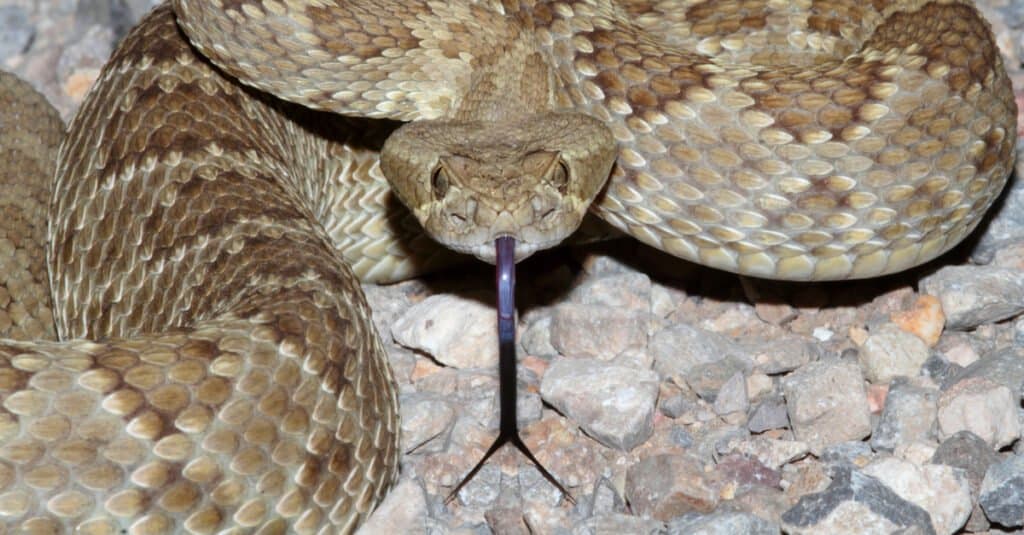
The Mojave Rattlesnake is widely considered the most deadly snake in the United States.
©Steve Byland/Shutterstock.com
There are a lot of rattlesnakes in Arizona, in total about 13 different types!
Most are desert colored meaning they have a mixture of tans, browns, and blacks. Rattlesnakes are typically between two and six feet long. It’s very possible that you will see a rattlesnake when you are out and about in Arizona, especially if you’re in State Parks or other recreational areas. So you should always be cautious when you’re hiking, camping, or doing any outdoor activities in Arizona. Rattlesnakes are masters of disguise so watch the area around your feet very carefully and always listen for that that telltale rattle.
How common are rattlesnake bites in Arizona? Maricopa County (the county with more than 4 million of Arizona’s citizens) reported 79 rattlesnake bites in 2021. Rattlesnake bites can be extremely painful, but when treated properly are rarely fatal. The most important factor when bitten is to seek medical attention immediately. The rattlesnakes in Arizona include:
- Sidewinder Rattlesnake
- Arizona Black Rattlesnake
- Great Basin Rattlesnake
- Hopi Rattlesnake
- Mojave Rattlesnake
- Tiger Rattlesnake
- Ridge-nosed Rattlesnake
- Northern Blacktail Rattlesnake
- Speckled Rattlesnake
- Praire Rattlesnake
- Western Diamondback Rattlesnake
- Twin-Spotted Rattlesnake
- Grand Canyon Rattlesnake
A Complete List Of Snakes In Arizona
Snakes can hide very well in the desert, and much of Arizona’s landscape is desert. So you need to be very careful when you’re outdoors in Arizona. Always scan the area in front of you and to both sides so that you will see snakes before you are so close to them that you startle them. A complete list of snakes in Arizona is:
- Arizona Milk Snake
- Mountain King Snake
- Patch-Nosed Snake
- Black-Neck Garter Snake
- Blind snake
- Checkered Garter Snake
- Coachwhip Snake
- Common King Snake
- Desert King Snake
- Gopher Snake
- Glossy Snake
- King Snake
- Ground Snake
- Desert Rosy Boa Snake
- Saddled Leafnose Snake
- Sonoran Gopher Snake
- Spotted Leafnose Snake
- Long-nosed Snake
- Western Hognose Snake
- Arizona Coral Snake
- Mexican Vine Snake
- Tropical Vine Snake
- Sidewinder Rattlesnake
- Grand Canyon Rattlesnake
- Arizona Black Rattlesnake
- Great Basin Rattlesnake
- Tiger Rattlesnake
- Lyre Snake
- Mojave Rattlesnake
- Night Snake
- Northern Blacktail Rattlesnake
- Prairie Rattlesnake
- Arizona Ridge-Nosed Rattlesnake
- Southwestern Blackhead Snake
- Speckled Rattlesnake
- Coral Snake
- Western Diamondback Rattlesnake
- Western Shovelnose Snake
- Twin-Spotted Rattlesnake
Black Snakes in Arizona
If you want to be more specific in your study of snakes in Arizona, take a look at our article on the black snakes in this state. Talk about variety! Among these 7 are 2 venomous and 5 nonvenomous varieties. Even though classified as black snakes, some may have yellow or red underbellies or a white head, so we are still looking at colorful snakes. We have pictures of them all, so take a look.
Bonus: What U.S. Rattlesnake Species Are the Most Dangerous?
Rattlesnakes are among the most deadly venomous snakes in the U.S. But their bites vary in toxicity, so it’s a good idea to be educated on what rattlesnakes are the most dangerous.
Mojave Green Rattlesnake

Some experts classify the Mojave green rattlesnake as the deadliest rattlesnake species in the United States.
©iStock.com/Shoemcfly
Many experts classify the Mojave green rattlesnake, native to the Southwestern U.S. as well as Mexico, as the deadliest rattlesnake species on Earth. Its venom, which can be either hemotoxic or neurotoxic, can cause symptoms like vision impairment, difficulty swallowing and breathing, muscle weakness, severe body pain, convulsions, and death by cardiac arrest or respiratory failure if left untreated.
Eastern Diamondback Rattlesnake
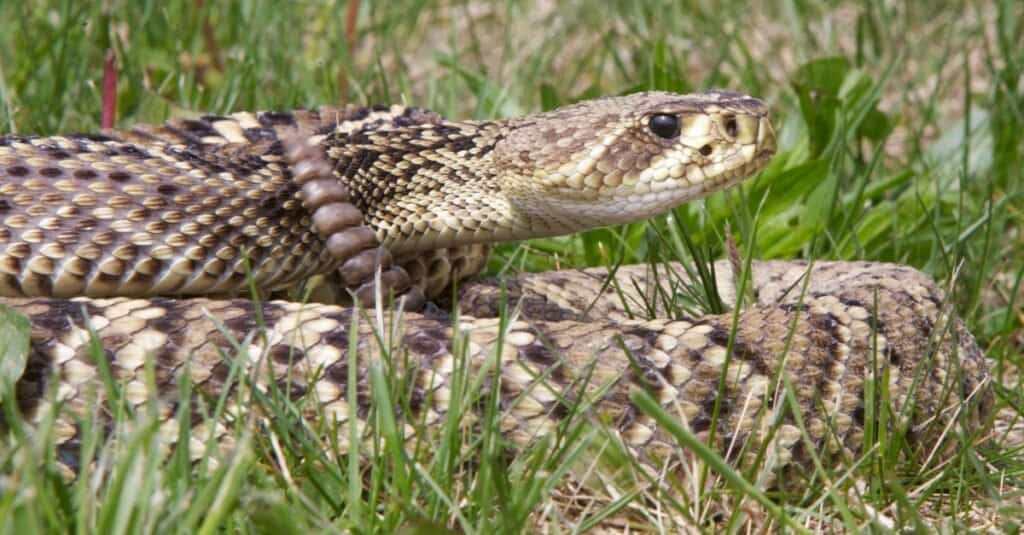
The Eastern diamondback rattlesnake is responsible for the most deaths in the U.S. from snake bites.
©iStock.com/NajaShots
This rattler is another contender for the deadliest rattlesnake in the United States. It’s also one of the largest snakes in the U.S., growing to a max length of 8.5 feet and max weight of 34 pounds. Its bite contains hemotoxic venom, capable of killing red blood cells and causing tissue damage. Another problem lies in the fact it can deliver 400-700 mg of venom in its bite, compared to 200-300 mg in the western diamondback rattlesnake, so its venom can lead to death. The Eastern diamondback rattlesnake is recognized as being responsible for the most deaths by snakebite in the U.S.
Western Diamondback Rattlesnake
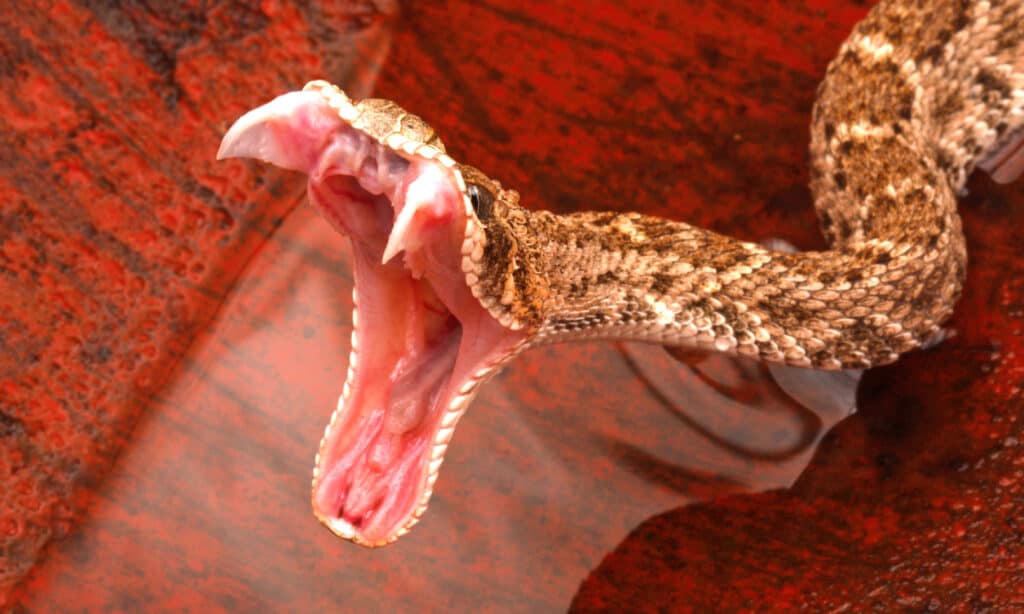
The venom from a Western diamondback rattlesnake is hemotoxic, attacking red blood cells and causing tissue damage to bite victims.
©iStock.com/johnaudrey
Close on the heels of the Eastern variety is the Western diamondback rattlesnake, native to the U.S. Southwest and northern Mexico. Its venom is hemotoxic, killing cells and tissue, causing blood clotting (or preventing clotting) that can result in massive internal bleeding, and causing possible cardiovascular failure. Some experts think this type of rattlesnake actually outranks the Eastern diamondback in terms of overall deaths to humans.
Other deadly U.S. rattlesnake species include:
- Timber Rattlesnake
- Massasauga Rattlesnake
- Southern Pacific Rattlesnake
- Banded Rock Rattlesnake
- Desert Massasauga Rattlesnake
The photo featured at the top of this post is © Steve Byland/Shutterstock.com
Discover the "Monster" Snake 5X Bigger than an Anaconda
Every day A-Z Animals sends out some of the most incredible facts in the world from our free newsletter. Want to discover the 10 most beautiful snakes in the world, a "snake island" where you're never more than 3 feet from danger, or a "monster" snake 5X larger than an anaconda? Then sign up right now and you'll start receiving our daily newsletter absolutely free.
Thank you for reading! Have some feedback for us? Contact the AZ Animals editorial team.






